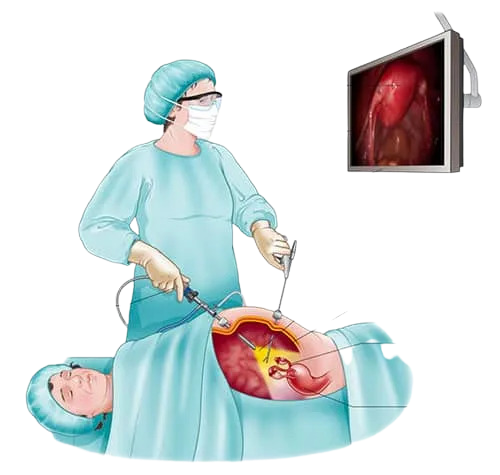Tubal Cannulation
Home > Gynae Treatments > Tubal Cannulation

Tubal cannulation, also known as fallopian tube cannulation, is a medical procedure used to open blocked or narrowed fallopian tubes. The fallopian tubes are essential for fertility, as they provide a pathway for the egg to travel from the ovaries to the uterus and for sperm to meet the egg for fertilization.
When one or both fallopian tubes become obstructed due to conditions like tubal scarring, mucus plugs, or previous infections, it can hinder natural conception. Tubal cannulation is a minimally invasive technique performed to address these blockages and restore the fallopian tubes' patency.
During the procedure, a catheter or a thin, flexible tube is gently guided through the cervix and into the fallopian tubes under the guidance of imaging technology such as fluoroscopy or hysteroscopy. Once the catheter is in place, a contrast dye or a special solution is injected to clear the obstruction or dislodge any mucus plugs.
Tubal cannulation is generally a safe and effective procedure, and many women experience improved fertility following the treatment. However, the success of the procedure depends on factors like the extent of the tubal blockage and the underlying cause.
Laparoscopic tubal cannulation is a minimally invasive procedure used to open blocked or narrowed fallopian tubes. It involves the use of a laparoscope, which is a thin, flexible tube with a camera and light at its tip. The laparoscope allows the surgeon to visualize the pelvic organs and guide the cannulation process. Here is an outline of how laparoscopic tubal cannulation is typically performed.
Tubal cannulation is done under general anesthesia to ensure they are unconscious and do not experience any discomfort during the procedure. Several small incisions, each about half 3-5mm in size, are made in the abdomen. These incisions serve as ports through which the laparoscope and other surgical instruments can be inserted. Then laparoscope is inserted through one of the incisions, providing the surgeon with a clear view of the pelvic organs on a video monitor. Then surgeon examines the pelvic area, identifying the fallopian tubes and any potential blockages or abnormalities. Aftr identifying the affected part a guided wire is gently guided into the opening of the blocked or narrowed fallopian tube. A sterile saline solution is injected through the cannula into the fallopian tube. The pressure from the solution helps to open up the tube, clearing any mucus plugs or debris that may be causing the blockage.
Laparoscopic tubal cannulation offers several advantages compared to traditional open surgery or other treatment options for fallopian tube blockages. Some of the key advantages include:
Minimally Invasive: Laparoscopic tubal cannulation is a minimally invasive procedure, which means it requires only small incisions in the abdomen. This results in less post-operative pain, reduced scarring, and faster recovery compared to open surgery.
Shorter Hospital Stay: Most patients undergoing laparoscopic tubal cannulation can go home on the same day of the procedure or after a short hospital stay. This allows for a quicker return to normal activities and daily routines.
Lower Complication Rates: The risk of complications is generally lower with laparoscopic tubal cannulation compared to open surgery. The smaller incisions reduce the chances of infection and other surgical-related complications.
Improved Fertility: For women with fallopian tube blockages, successful tubal cannulation can restore fertility by opening the tubes and allowing the passage of eggs. This can increase the chances of natural conception without the need for more complex fertility treatments.
Accurate Visualization: The laparoscope provides a clear and magnified view of the pelvic organs, allowing the surgeon to precisely guide the cannula into the blocked or narrowed fallopian tubes.
High Success Rates: When performed by experienced and skilled surgeons, laparoscopic tubal cannulation has a high success rate in opening blocked tubes. The procedure can significantly improve the chances of pregnancy for women with tubal infertility.
Faster Recovery: Recovery time after laparoscopic tubal cannulation is typically shorter compared to open surgery. Patients can resume regular activities sooner and experience less post-operative discomfort.
Diagnostic Benefits: During the laparoscopic procedure, the surgeon can also assess the overall health of the pelvic organs, including the uterus, ovaries, and surrounding tissues. This can help identify any other potential fertility issues or conditions that may require further treatment.
Overall, laparoscopic tubal cannulation is a safe and effective option for women with blocked fallopian tubes who desire to restore their fertility. However, the success of the procedure depends on individual factors, including the cause and severity of the tubal blockage and the patient's overall health. Women considering laparoscopic tubal cannulation should discuss their specific situation with a fertility specialist to determine if this procedure is the appropriate choice for their fertility goals.

Our laparoscopic team of surgeons in Lahore takes pride in housing the finest team of laparoscopic surgeons specialized in providing top-notch tubal cannulation services. With a wealth of experience and expertise in minimally invasive procedures, our skilled surgeons are dedicated to helping women overcome fallopian tube blockages and restore their fertility. Using state-of-the-art laparoscopic techniques. Our team ensures precise visualization and accurate guidance during the procedure, leading to optimal outcomes for our patients. We are committed to delivering exceptional care and personalized treatment plans, tailoring each approach to suit individual needs. Rest assured, our team's proficiency and compassionate approach make us a trusted choice for those seeking the best tubal cannulation service in Lahore.
Contact UsCopyright @ . Design By Blizin Technologies